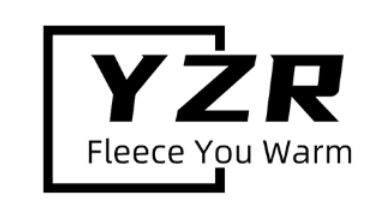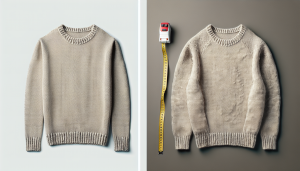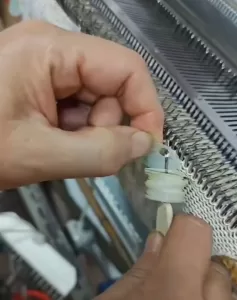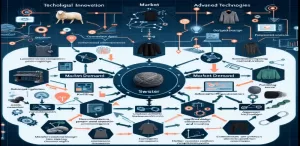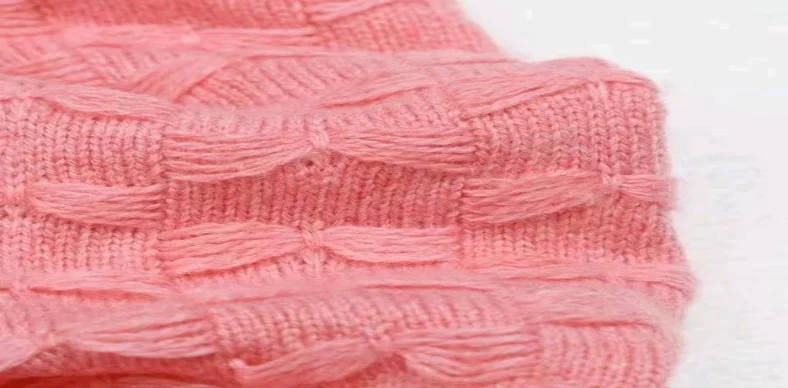
Woolen sweater factory computerized flat knitting machine application of appliqué design
I. Principle
The color jacquard pattern produced by the traditional jacquard process has the following shortcomings:
- Heavier fabric weight: Since colors not appearing on the front side need to be woven in additional cross rows on the reverse side of the fabric, this results in heavier fabric weight. Even with a single jacquard organization, the weight of the fabric is increased by the presence of floating threads on the reverse side of the fabric.
- Color block mixing: The color blocks of jacquard patterns are not entirely monochromatic but are mixed with loops or floating threads of other colors.
The jacquard pattern process uses the following principle: the yarn guide for each color yarn is padded only in its own color area. When the padding in the area is finished, the yarn guide stays in place until the next row of machine heads returns to drive the weaving. At the edge of the next color zone, another yarn guide continues knitting the row.
In the past, on specialized flat knitting machines, the production of a complete train required the use of a variety of different yarn guides with a large number of positioning blocks to ensure that the guides were positioned accurately. At the same time, as the number of guides increased, the position of the guides needed to be adjusted, adding to the complexity of the machine.
Now, by controlling the movement of the guides with a computer, it is possible to drive or drop each guide anywhere across the width of the weave, without the need for specialized positioning blocks. Advanced software stores the working position of each guide, making it possible to retrieve the guides in the next row. In addition, the computerized control of the machine head movement and the combination of the intarsia principle with other jacquard techniques allow the designer to apply intarsia to new three-dimensional patterns.
Second, simple appliqué
The process of forming intarsia tissue requires more weaving techniques than traditional jacquard, and they must be carefully combined to produce the desired result. Even to produce a simple three-color appliqué pattern such as the one shown in Figure 10-57, the following elements must be involved:
- Ground organization structure: Appliqué patterns can be produced using any of a number of knitting structures, such as flat knit, ribbed, or double reverse organization. The simplest and most commonly used of these is the flat-needle organization, which involves only the needles of the front needle bed in the knitting, thus making the fabric lighter in weight.
- Joining between color blocks: Knitting involves joining the last vertical row of one color block to the first vertical row of the next color block. This can be achieved by forming a loop or group structure on the same newspaper needle between two color blocks.
- System adjustment: Depending on the designed appliqué organization, it is necessary to take into account the direction of the machine head movement in coordination with the desired organizational structure, as well as the final position of the yarn guides.
- Arrangement of the yarn guides: Special anchor yarn guides must be used for the production of appliqué patterns. These guides are designed to enter or exit the work at the beginning and end of the color block.
- Movement and non-movement of the yarn guides: Each appliqué guide is a complex mechanical device consisting of a brake and an oscillating mechanism. During the weaving process, the guide needs to move or remain motionless according to the designed pattern.
- Computer-controlled movement of the guides: The weaving program includes the movement of the guides and the positioning of the guides after the traverse of each pattern. The movement of the yarn guides can be realized by different commands.
- Pattern Chart: The pattern chart contains information about the design of each pattern row and the connections between the color blocks.
- knitting program: in the knitting program, it is necessary to specify the moving area and action of the yarn guide, as well as the connection between the color blocks.
The above is about the application of computerized flat knitting machine appliqué design of the basic principles and key points, through precise control and combination, appliqué technology can achieve more complex pattern knitting, for textile design to bring more possibilities.
